The last day has seen the imposition of new travel restrictions and spreading alarm about the Omicron variant. It sure looks like a repeat of what happened with Alpha and Delta, as well as the original strain back in early 2020, and that we are probably doing this again.
How will this play out this time? It’s very early. There’s tons of unknowns. Yet there is a lot we can say already, and many actions need to happen now to have any hope of doing much good. So it’s time to move fast, see what we can say right now and try to capture the speed premium.
I’ll start with a summary of what we know about the game board based on previous experience, then look at what we know about Omicron and what moves have been played so far in this round.
I was almost finished with this post when the WHO decided to go with Omicron instead of Nu (or even Xi) and then I had to go through and replace Nu with Omicron about 25 times. We could have just said ‘the Nu variant’ a lot but the WHO hates both efficiency and fun even more than it hates freedom, it seems. Sad.
The First Three Times
In early 2020, we got warnings about a new potential pandemic. Almost all reactions were too little too late. What warnings I offered were less too late than most, but still too tentative and too late.
About a year ago, as the Alpha variant was spreading, it seemed like the same pattern was happening again. It was clear Alpha would take over. I extrapolated into the future, did the math as best I could, wrote the post We’re F***ed, It’s Over, noted the unknowns, and predicted a 70% chance of a large wave between March and May.
As I noted in the later update, it was not over. There was no big wave between March and May of 2021. Alpha wasn’t as additionally infectious as I expected, but it wasn’t that much less additionally infectious than I expected, and I didn’t have enough respect for several factors including seasonality. In hindsight the 70% prediction was somewhat overconfident, and a prediction of about 45% would have been better.
Then, as it looked like things would have otherwise died down and normal life resumed, Delta arrived. It was quickly clear it would not be contained for long and Delta would take over. The situation in India seemed super scary, with hospitals overwhelmed and the serious possibility Delta would sweep through the entire population, first in India and then around much of the world.
Then India’s situation stabilized quickly, and it seemed clear we had sufficient vaccinations plus control system reactions to prevent things from getting too far out of hand. There would be a wave now, perhaps another in winter, but it would not be a crisis.
Winter is now coming, and that winter wave is clearly already underway, except now we are likely to also face the Omicron variant.
If Omicron Is What We Think, We Cannot Stop It, Only Slow It Down
Before we get to the details of the Omicron variant, it’s worth taking a step back and asking what we know about such developments in general, and how things are likely to play out and what options might be available.
The first point is the obvious one. There is no stopping a variant that is substantially more infectious than Delta. If Omicron is indeed substantially more infectious than Delta, it will become the dominant strain throughout the world.
Once there are hundreds of detected cases, it is already far too late to successfully contain the new variant. By the time we have enough information to react to a new variant, there will already be hundreds of detected cases. We lose. Good day, sir.
That doesn’t mean there are no physically possible measures that could contain the new variant once there are hundreds of detected cases. It does mean none of them are remotely in the Overton Window, or logistically within the abilities of our governments even if they decided to try anyway. Playing to win the game is not an option here. We lose.
That doesn’t mean we can’t or shouldn’t do things that make us lose slower. We can absolutely slow down the pace at which Omicron displaces Delta.
Whether or not that time is useful depends on what we do with that time.
Perhaps not very much time. The worse Omicron is, the more rapidly it will take over and the less time we can buy with countermeasures. In practice, in terms of the takeover rather than the overall number of infections, we could likely buy ourselves a week or two, but it’s hard to see us buying more than that. We could also institute general restrictions against Covid-19 to reduce the number of infections across the board. Once again, we buy ourselves a small amount of time.
If buying time before a sufficiently large wave gets us better access to Paxlovid or other treatments, or allows us to get a lot more people booster shots that still work, or time to make a new version of the vaccine and roll it out, time can be quite valuable.
There’s also the possibility of stalling to get better seasonality effects when crunch time happens. The wave maxing out in December seems like maximally bad timing, and we’d prefer to push it to January or February.
If you buy time and then it is wasted, then nothing is gained. If you pay a big price to buy time, it needs to be paired with a similarly big effort to make use of that time.
Travel Restrictions
The first step is always a debate over travel restrictions. Travel restrictions feel like Doing Something, and failure to impose such restrictions opens the door for blame.
When the WHO warned against travel restrictions, that’s when I knew in my gut what we were dealing with.
Travel restrictions are an excellent idea when the goal is to buy time. They can definitely slow down the rate at which the new variant spreads across borders.
What they can’t do is stop it entirely, even if they are imposed early enough, unless you’re sufficiently serious.
Sufficiently serious means actually closing off or at least aggressively quarantining everyone who has any exposure to the areas in question, which includes any areas not taking similar measures, anywhere. There can’t be exceptions, including for your citizens.
Realistically, your minimum case that could possibly fully work is to be Australia, and quarantine everyone at the border even if there’s no reason to suspect anything, and you need to do it right. That’s not going to happen.
Even if you did succeed, what then? How long are you going to keep your borders closed? A restriction to a few countries might help the first week, but within a month it won’t even much matter, because there’s too much spread elsewhere. It’s not like a variant worse than Delta is going to go away any time soon, so you’re stuck in a permanent state that in most places both can’t be created and can’t be sustained if you did create it.
For those places that showed they can sustain it, would you even want to, and for how long? When would it end? What’s your plan?
The other issue with travel restrictions is they continue long, long past the time when they still make any sense. Once containment has generally been lost, the restrictions don’t do anything. At a minimum, they do nothing unless you’re in a much much better place than the region you’re cutting off, whereas there were many cases of longstanding mutual restrictions where the same variant was dominant in both places, which is pure folly.
It does seem like ‘impose travel restrictions aggressively to buy time’ is a good response. The short term cost is very low, and with so many unknowns the upsides are very high. If you do that, you need to do it very quickly. The best time is a week ago, the second best time is right now, and all that. In the scenarios where it matters most, a week from now there won’t be much point.
Exactly what restrictions are imposed by who, and when, provides strong insight into how various governments respond to new information.
Lockdowns
It’s worth noting that if a new variant is about to displace the old one, then lockdowns designed to stop the spread of the old variant are much less worthwhile. Once there’s a displacement event, the previous infection level no longer matters at all. If anything, previous infections could be an advantage, if the new variant is more dangerous, and/or it means the spread can be slowed down due to natural immunity. The flip side is if somehow natural immunity was going to stop working entirely against the new variant, then every case prevented in the meantime is a pure extra case, which based on history seems unlikely but is possible.
The bigger reason to reconsider existing lockdowns is that there are increasing marginal costs for lockdowns, and a limited capacity to impose them. The early efforts to stop the spread ‘used up’ a lot of that capacity. Lockdowns now, before the crunch time, could end up having little effect and also making it impossible or more expensive to lockdown again later when it matters most. To the extent that lockdowns are a good idea, they need to be timed carefully.
The counterargument to that is that a lockdown suppresses overall transmission levels of the new variant as well. Even if you have only 10 cases, if you slow down spread from those 10, that’s worth a lot and buys you time. That’s true, but mostly only works if you’re no longer importing meaningful numbers of cases from elsewhere, and for various dynamic reasons the amount of time you buy here won’t be very large.
You can also attempt to do a lot of sequencing, then do aggressive quarantines and contact tracing when you find the new variant, but the capacity to do this enough to matter is not present.
Vaccinations
The best defense against prior waves and variants has been vaccination. Every time a new variant arrives, fears are stroked that the vaccines will stop working, or will be less effective.
Despite that, we’ve had months in which we could easily have updated the mRNA vaccines to fully match the Delta variant, we are now giving out booster shots even, and still no sign of any attempt to modify the vaccines.
I’m unsure how much evidence this is against the need to update the vaccines. If the vaccines had stopped working entirely, or taken a sufficiently strong hit, presumably we would have updated to a new version. The FDA has promised to look kindly upon such changes, and it seems like it could only help on both health and financial considerations. My guess is it’s actually quite a bit of evidence against any strong potential gains from updating, but weak evidence against weak gains.
So far, all talk of immune escape has mostly been exactly that, talk. That should make us wary of expecting it out of a new variant, or of updating too much from people’s concerns.
If a new variant comes along that does offer substantial escape from the vaccines, we will need to update the vaccines and get new versions out as quickly as possible. Will we be able to do that?
Technologically I have no worries. We’ll have that part solved within the week and probably within one day.
Engineering I’m also not worried about. My understanding is this is at most a two week process. There are still concerns about rate of production, since we were stupid enough not to scale this up enough in advance, but we’ll take whatever we can get.
It therefore comes down to the FDA making good on its word to allow this to happen, and then on our ability to distribute the new boosters and communicate effectively why they are necessary and get people to accept them. In the short term, we don’t need to worry that much about communication, so that has more time to get its act together.
The other worry is that if Omicron is sufficiently worse than Delta, especially if it combines being otherwise worse with immune escape, the amount of time available might be quite short. Even if everything went smoothly the full process would still take months. We could go faster in theory, but that would require efforts on a different level than we made the first time or have accomplished in a long while on anything. I’m not optimistic.
Biological Priors
When we see a new variant spreading rapidly, what should our priors be about its biological properties?
Note that these are all things we should think are likely rather than anything that we know.
We have explored various potential mutations a lot by now, so we should put a lot of weight on what those mutations imply about the variant’s likely behavior.
We should presume that if something takes over quickly, it has a very large advantage infecting people who are unvaccinated and lack natural immunity.
We should presume that if it also has an additional property of vaccine escape, that seems like quite a coincidence, so it seems unlikely.
We should consider this even more unlikely if the variant started out in places with low vaccination rates.
We should also presume immune escape from either natural infection or vaccination is unlikely from our track record of Alpha and Delta not having this property.
We should presume there will still be more ‘breakthrough’ infections but that this comes from the protection levels no longer being sufficient because the new variant is easier to catch in general, not because the particular protections you have stopped working.
We should presume at this point some positive correlation between infectiousness and virulence, since both are likely tied to how much virus is typical (viral load), and previous variants followed this correlation.
We should be more confident in these things if our tests still work than if they start to fail.
What Do We Know About Omicron?
There have been a bunch of threads attempting to answer this question.
Here’s Eric Feigl-Ding, from Thursday around noon (things are moving rapidly, so timestamps are important).
I’m going to err on the side of directly putting in too much of these threads rather than too little, in the interest of speed, and to offer an easy option to get closer to the sources.
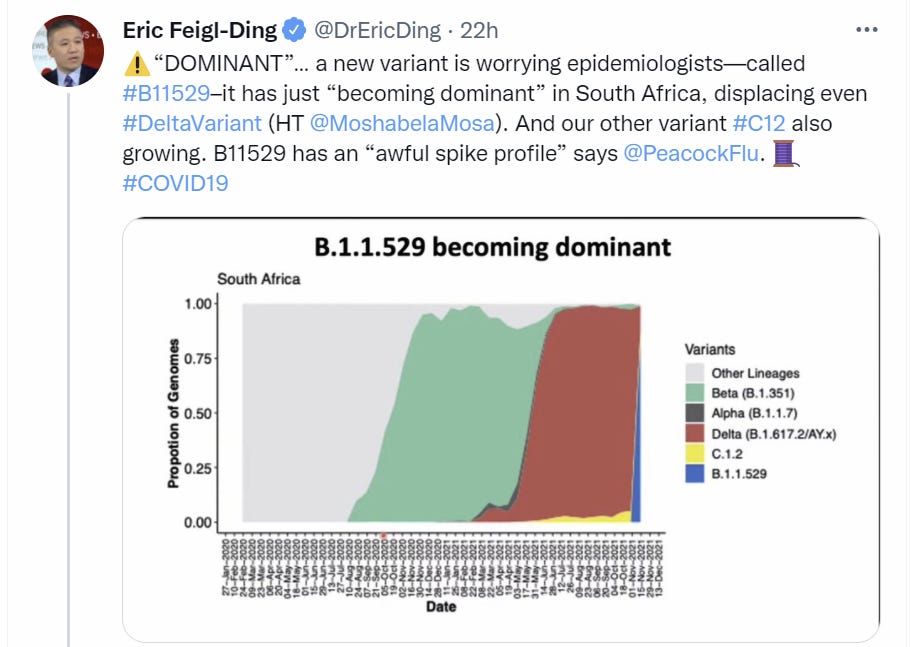

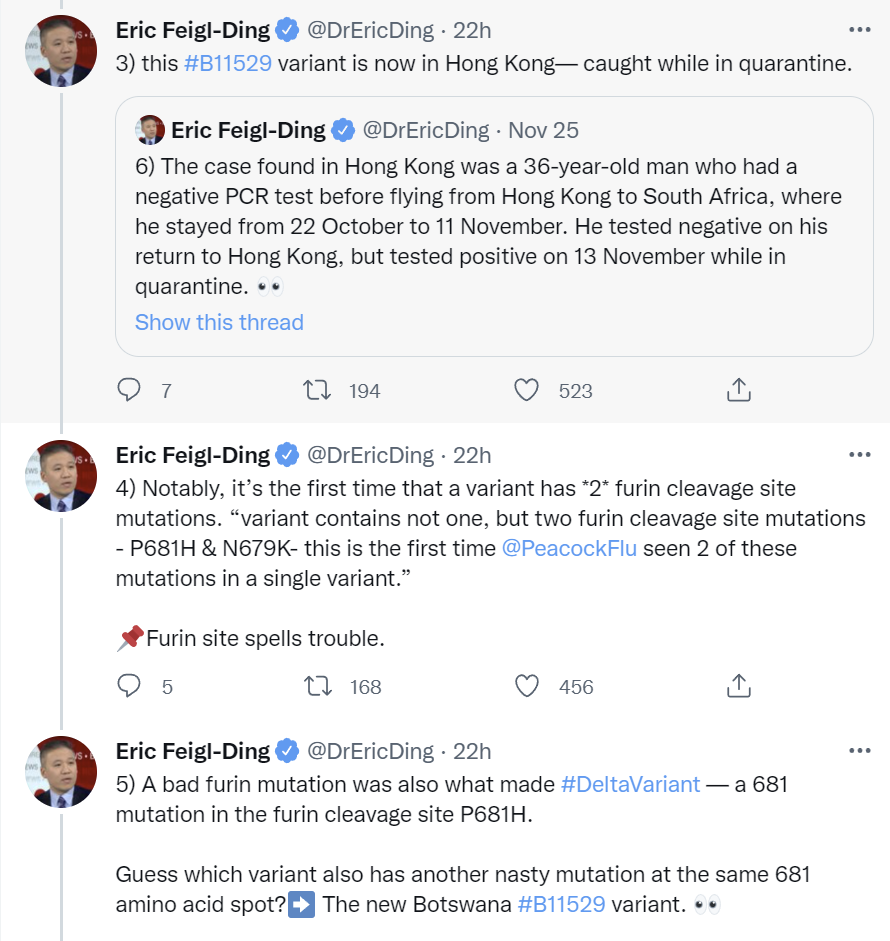

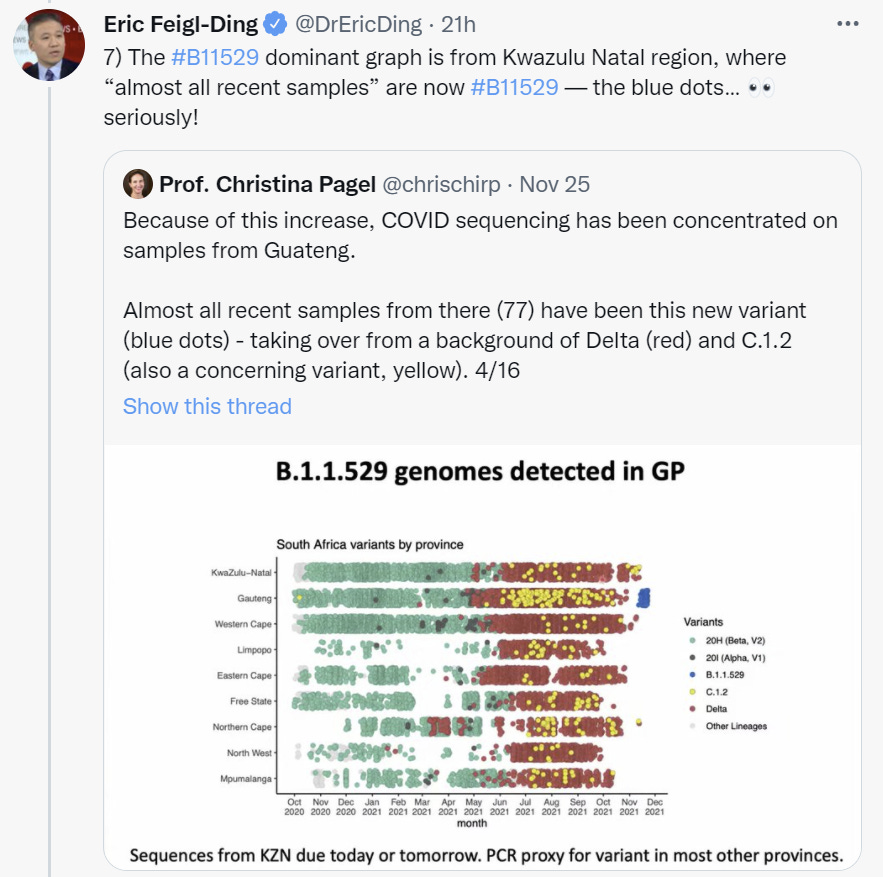





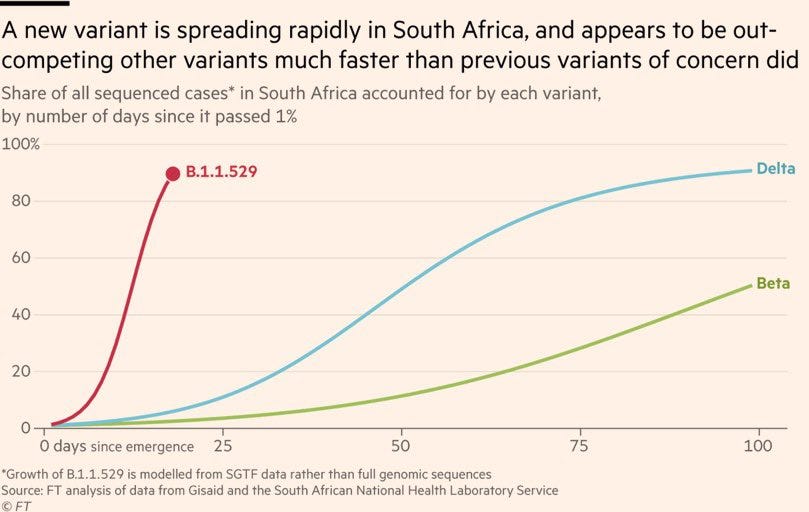
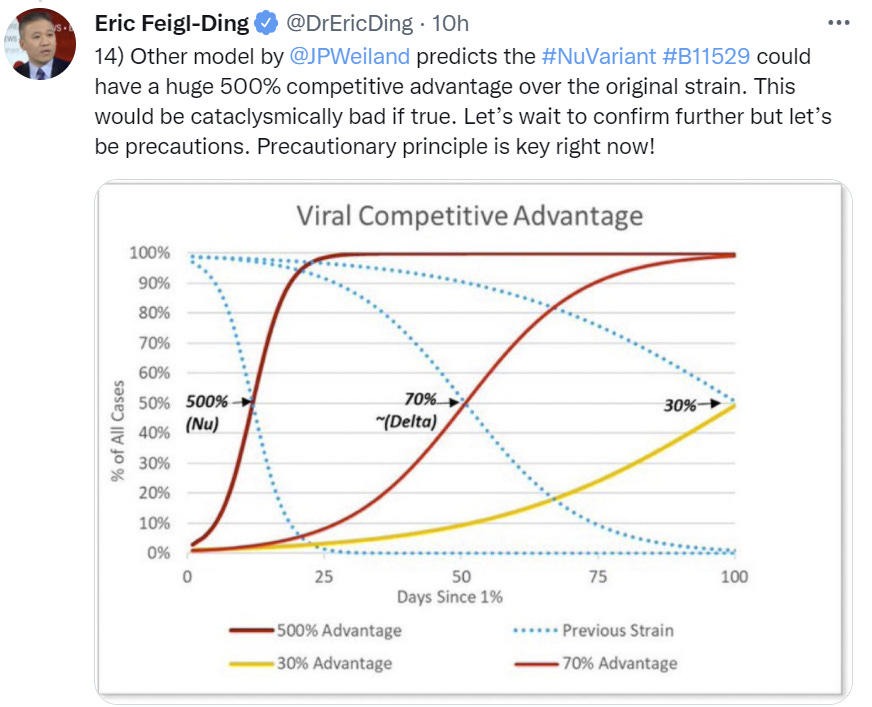
I think this final graph is a bit confused here, unless ‘the original strain’ here means Delta. Delta had about a 120% advantage over ‘the original strain’ or 70% over Alpha. I’m going to take this to mean 500% as compared to that 120%, so 600% of original versus 220% of original, or about a 170% additional increase. Which is… better, but still quite a lot.
The graph above it does seem to imply that the Omicron advantage over Delta is being modeled here to be several times larger than the Delta advantage over Alpha/Beta, where ‘modeled here’ means looking at share of all cases in the country over time. This is a super scary graph, assuming it is accurate.
There’s also always the question of how this interacts with immune escape. Again, I’m using a baseline assumption that this is the same factor across the board regardless of level of immunity, and there isn’t an additional effect from escape of some kind.
South Africa’s vaccination rate is sufficiently low, and this rate of spread so high, that it wouldn’t much matter if there was vaccine escape properties, although it would presumably matter if there was escape from natural immunity.
Straight talk: If it’s 500% above Delta, in the way I understand it, We’re F***ed and it really really is over. At that point, it’s pure mitigation, and trying to flatten the curve a little bit, but yes everyone who isn’t immune is going to get this, and it would happen quickly. Under conditions where Delta would have had stable case counts, assuming a four day serial interval, this runs its course in America starting from a single case in about 50 days. If we assume 5 days per cycle, we get two months. Probably get somewhat more than that due to geographical barriers. There’d be a lot of attempted heroic prevention in the second half of that (the overall case number impact gets noticeable around the halfway point) and in particular in the endgame but in practice I doubt it much matters.
If it’s 170% above Delta, it changes how much time we have, and opens the door to meaningful action being possible to make things less awful. In particular, it gives a real shot to Paxlovid to be able to scale up in time to matter.
As always, such numbers are placeholders, approximations that simplify and mislead. Things aren’t that simple.
Here’s Bloom Lab, on the physical details:
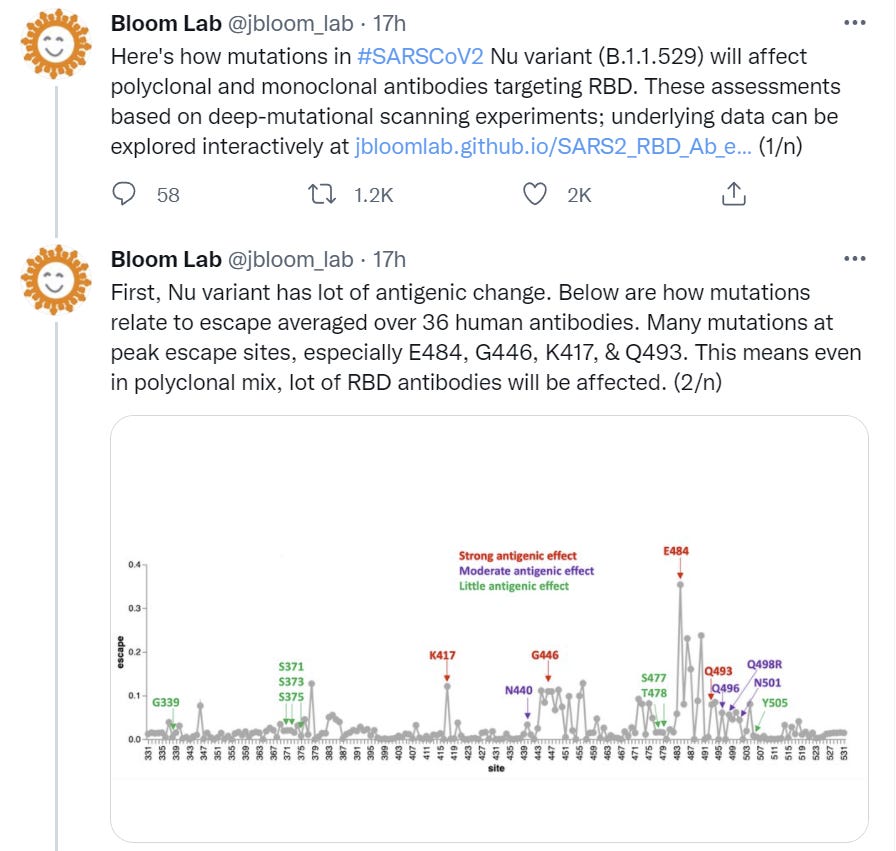








This is the Trevor Bradford thread. He concludes that selection from vaccinations did not drive variants in 2021, but that conditions are changing and such selection grows more likely over time.


This is an argument that the advantage that Omicron has comes largely from its escape properties – it has tons of escape properties, and South Africans can have lots of natural immunity even if they don’t have a high vaccination rate, which is leading to the rapid spread.
Note that while I don’t put zero stock in differential impact on natural immunity versus immunity from vaccination, I don’t put much probability mass there either. I’d presume until proven otherwise that they both will weaken about as much as the other.
I’d also presume that since vaccination without boosters is mostly sufficient to protect against severe disease, and boosters provide a gigantic boost to protection on top of that, and this is not going to fully escape, that a booster should still be sufficient to offer practical protection against the variant, and non-boosted vaccination should still provide strong protection although potentially not as robust as before.
Note that this being about escape is in some ways good news. If it’s about escape, then we don’t have any reason to presume that the new variant is deadlier, or presents something we can’t defend against by renewing our defenses.
I also don’t see any reason to think that any of this would make Paxlovid or other non-antibody treatments less effective, so we’ll still have all of that in our arsenal.
Then again, Bloom Lab points out that there’s a contrasting viewpoint, and some chance it’s worse than all that, although I’d still consider it highly unlikely:


This thread calls for help for South Africa to ‘help contain’ the virus, and to avoid ‘isolating’ the country. I don’t see how one could hope to contain anything at this point, regardless of help, or how not isolating could make sense. The call to provide other kinds of help seems right.
Here’s the final big thread that seemed worthwhile.
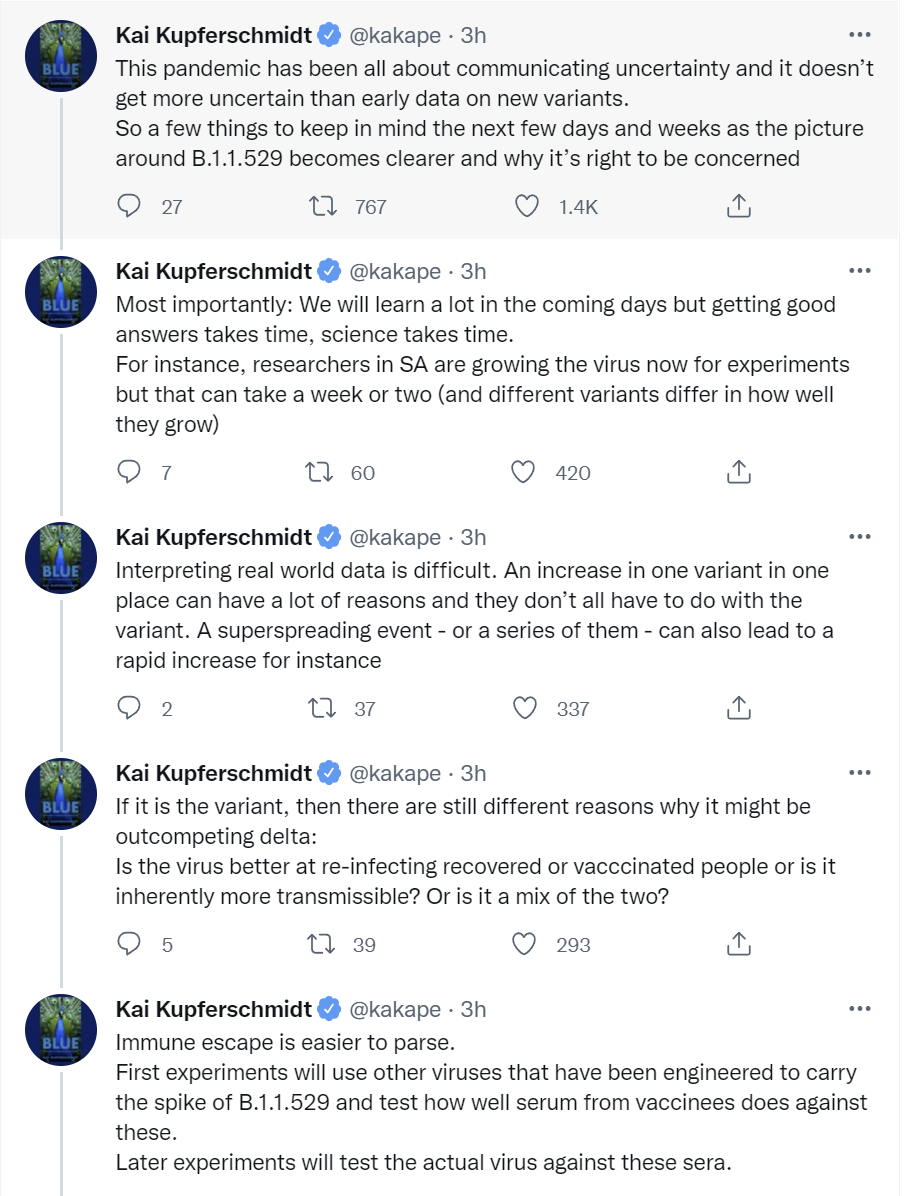
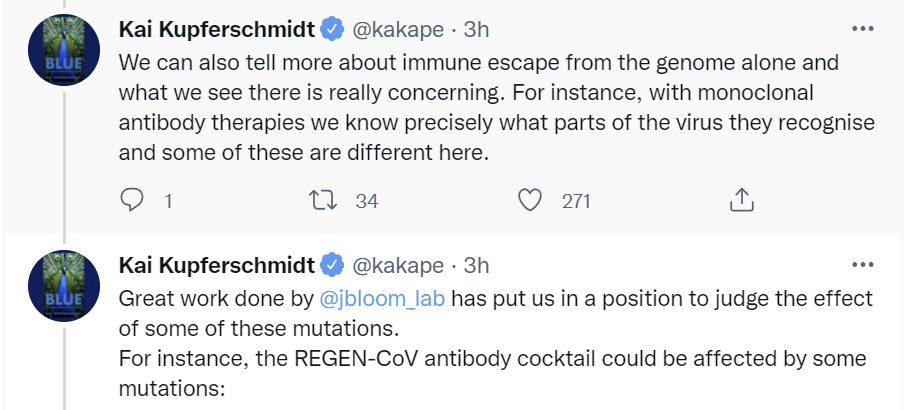
Link above is to the 7th post in the Bloom thread above, below to the 2nd one.


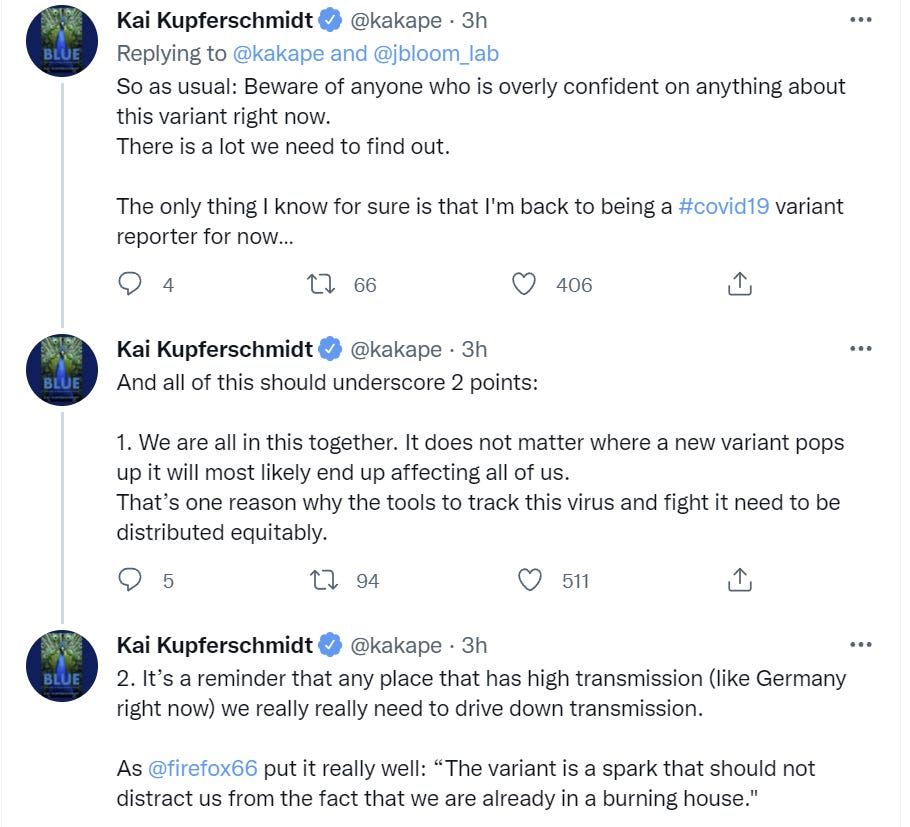
This seems like the reasonable skeptical take. Things could be quite bad on any number of fronts, but we don’t know much yet. I agree that any pronouncements on severity should be treated with even more extreme skepticism.
Putting it all together, it seems likely that at least some of the advantage here comes from escape, or what Kai prefers to call immune erosion, but that we can be confident that this will only be partial.
We can’t be sure how much additional transmission advantage Omicron will have on top of that, but the Hong Kong case is suggestive given there are so few other cases abroad, and this level of rapid spread seems unlikely to happen only (or even primarily) from immune erosion properties. In the scenarios where the growth rate is ‘real’ in the sense that it reflects a very high transmissibility advantage for Omicron, I’d be very surprised if it wasn’t better at spreading among the unvaccinated never-infected.
What’s Going on in South Africa
Concretely here’s the situation:


That’s not a very large red area on the right, but it is a very rapid rise. Still a chance this is all a blip. We will know more very soon.
The overall levels are still small, compared to places like the United States:
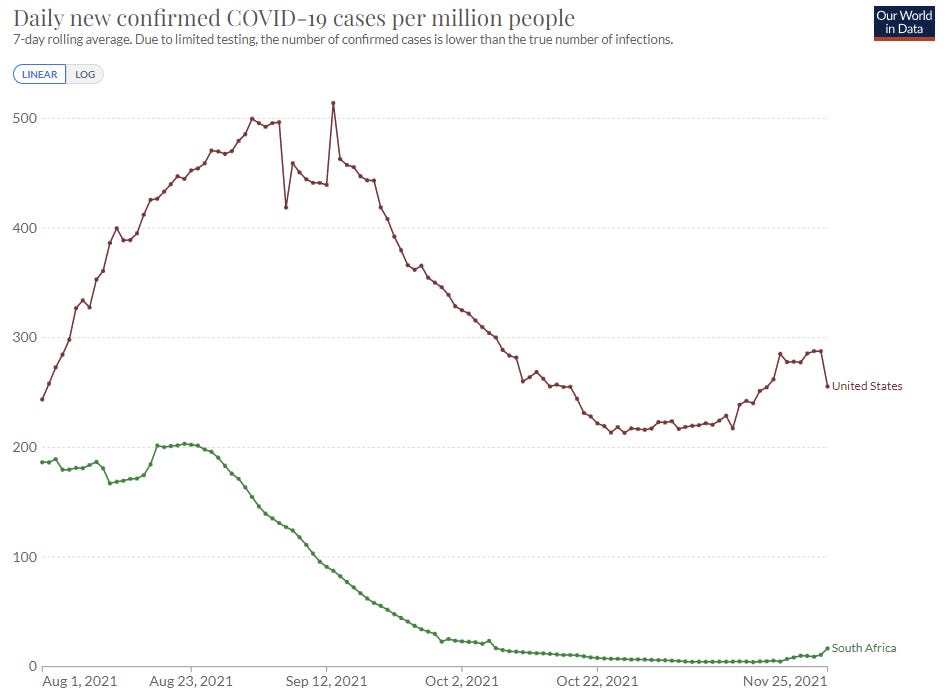
You might think this is lack of testing, but no, it’s not.
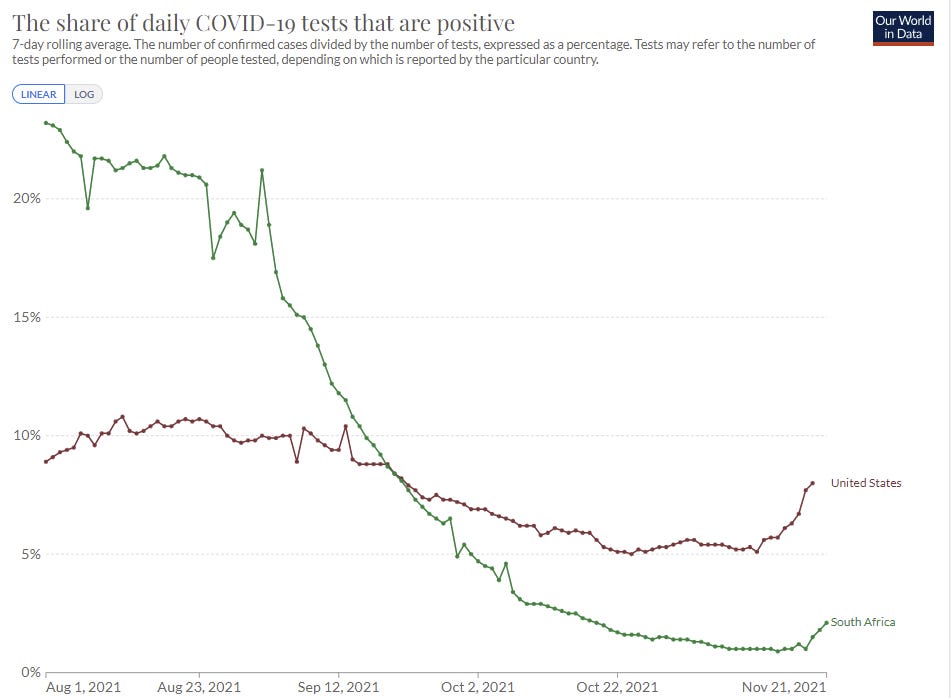
This is the biggest reason to think this could all still be a false alarm. A large rise from a very small number means a lot less.
Despite this, of course, it’s still too late to contain the situation, which is why I’m saying that we will basically never contain such situations. A few thousand cases is too many to come back from, and we’re already seeing cases in many other places – one in Belgium, one in Hong Kong and one in Israel.
World Reaction
The financial markets are taking this seriously. You can never be sure about such things, but from what I’ve seen the details of what is moving in what direction sure look like this is the ‘Covid beta’ rather than something else.
The large decline in Crypto is especially interesting, because we saw a similar thing in 2020 that at the time clearly didn’t reflect long term prospects and was based on the flows that happen in such situations. At the time I was too distracted to pull the trigger, which is quite sad. If the current move gets much bigger, then to the extent that one wants to be long, it seems like a potential opportunity to buy cheap (Not Investment Advice!).
That market reaction was motivating to get me to look at this quickly and take it seriously, and is definitely influencing my probability of this being ‘for real’ quite a bit.
The other big response was, of course, travel bans. The WHO warning against them is what got me to snap to attention and write this quickly, which also tells you what I think of the WHO:

I have a lot of news sources, but for pure ‘just the basic things that are happening around the world regarding Covid’ my source of choice is the BNO Newsroom and in particular their twitter feed. Here’s some stuff that happened, in chronological order, after a lot of different news items about various new European case counts and restrictions over the previous few days.

As far as I can tell the WHO’s reaction was to attempt to stop nations from closing borders.
An accompanying press release did a standard call for preventative measures, which doesn’t seem connected to any model of how that would help.





The UK goes first and fast, cutting off travel from six countries rather than only South Africa, as one would do if taking this seriously. Of course, if taking this fully seriously you’d cut off everyone, but that’s a much bigger ask, especially at this early stage. Again, we never actually win at this, we only lose slower.
The note of a ‘threat to the vaccine programme’ looks to me like an important insight into the psychology here. The entire pandemic is seen through the eyes of the vaccinations, and as a fight to be won, rather than as a more broad situation in which vaccines are the strongest tool but the goal is to do the best we can in practice.
So we see the jump, as always, to ‘maybe the vaccines will stop working.’

Israel second. The UK did first doses first and otherwise took its own path to vaccine distribution, some would say even exiting the EU for related reasons. Israel did what it had to do to get more vaccine doses faster, and give them out quickly.
Those two being the first two to ban travel does not seem remotely like a coincidence.

The timeline says this jump came after the UK and Israel took action, which is impressive. The extra day’s data makes a big difference.

Direct link to the tracker here. Doesn’t appear to let you view things over time, so here’s the snapshot now, as I’m writing this, at 12:52pm on 11/26, during which time South Africa’s case count hasn’t been updated:
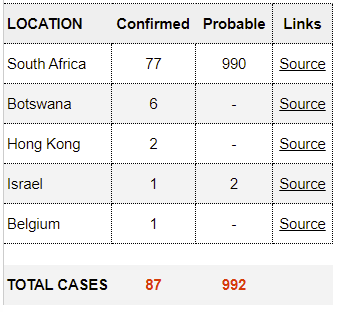

Singapore up next, and again, does this seem like a coincidence to you at all?

Israel and Hong Kong (and later Belgium) detected the first cases not in Southern Africa, while also seeming like the places that would notice such cases first. Let’s not pretend it hasn’t arrived here yet.

Note the contrast. The EU proposes a ban and will consider it. The UK went ahead and did it.
Not that every EU member was about to sit around and wait.






Germany noting the ‘variant of concern’ and then saying they’re ‘very worried’ while not stopping flights is an interesting news item there, while others drop the hammer. Short Germany?

As long as you don’t, ya know, actually do anything about it, as we’ll see in a second.



Oh well, nothing we can do about things like that.

Very glad to see that they did quarantine the entire flight.

Total failure.


Yes, I believe toast is an appropriate description.



We are still going to ‘wait for more information.’ Others do not have that luxury.

Less than a day still isn’t so bad – they did it while I was writing this. Kudos.


Seriously, WHO, could you people be any less helpful? We all agreed on Nu and now we have to type Omicron all the time? Couldn’t even use Xi?
Here’s their announcement.
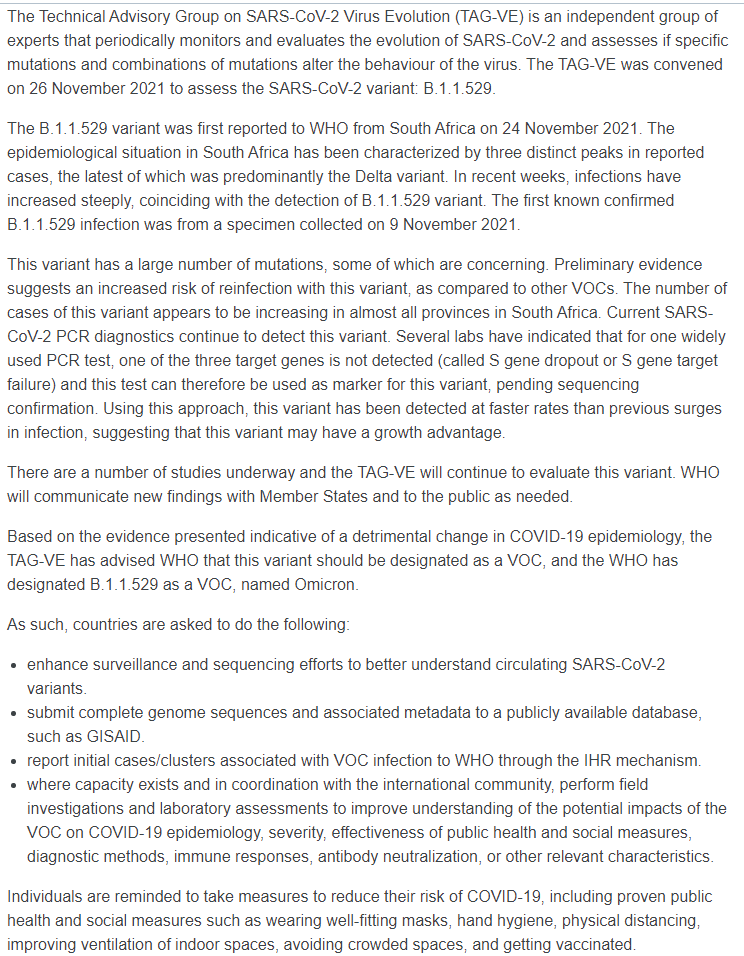
So please gather information and encourage everyone to take all the same measures as before, and otherwise do nothing.
A quick scan of the new Belgian report does not seem to indicate information I didn’t already have from Twitter. Here are its recommendations:
7. Recommendations
The identification of a first B.1.1.529 positive case in Belgium (but also at the European level) highlights the rapid international spread of this variant. Risk mitigation strategies should include travel restrictions or reinforced screening procedures at the international level (not only travels linked to South Africa), accelerating vaccination campaigns worldwide and accelerating the delivery of booster doses for the most fragile populations, reinforcing disease control interventions at all levels. Further, offering maximal support to African countries to ensure reinforced disease surveillance and control remains a high priority. These standard recommendations should shortly be updated based on the evolution of our understanding of the impact of this variant with regard to virulence, infectiousness, vaccine efficacy and activity of existing antivirals.
That all seems highly sensible, if incomplete.
EDIT: The actual moment I hit the send button, we did in fact restrict travel:
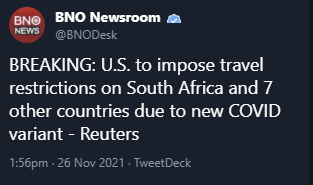
Then again, we didn’t actually do the thing, update accordingly.

Current Model
In the interest of the speed premium, I’m going to summarize my current thinking, while noting that I haven’t had that much time to think it over (nor has anyone else), and that my opinions will doubtless change quickly as the situation develops and also I have time to think.
Also, having to do this gives me a chance to do some intuition pumping.
These numbers are best guesses right now but please don’t take them too seriously or stick to them as the situation changes. If I don’t look stupid with some of these, then that would be me twisting my numbers to not look stupid. These numbers probably don’t live in the same universe and you could probably make very good bets against me by figuring out where they’re inconsistent, were I willing to book them, but these numbers aren’t supposed to be robust enough for that.
Anyway, here goes.
Chance that Omicron has a 100% or bigger transmission advantage in practice versus Delta: 30%.
The estimates in the threads were very large, including numbers like 170% and 500%, but I notice that my median estimate is far lower. That’s because the overall numbers are still small, and variants have a way of starting out spreading super rapidly for various reasons well in excess of how much better they end up spreading at equilibrium. This could all still be very overblown, and especially that’s likely in terms of the huge estimates of transmissibility advantage.
Chance that Omicron will displace Delta: 70%.
This implies there’s about a 40% chance that Omicron will displace Delta but with a <100% advantage, which seems at least reasonable.
In terms of this being a favorite at this point, I agree it’s still early, but also the pattern matching is way, way too good, and there weren’t any false alarms that got to this level of concern.
Chance that Omicron is importantly more virulent than Delta: 25%.
I mean everyone knows they don’t know, and this is definitely me guessing in a largely unprincipled way at this point. The virtue of putting a number on it even when you have no idea.
Chance that Omicron is importantly immune erosive, reducing effectiveness of vaccines and natural immunity: 50%.
There’s a lot of baseline biological reasons to suggest this, and there’s a lot of trust that this translates into actual effects, but will the effect be ‘important’? That’s harder to say, and we have skepticism from previous rounds. Seems likely that protection against infection will decline.
Chance that Omicron means the vaccinated and previously infected are no longer effectively protected against severe disease until they get an Omicron-targeted booster shot: 5%.
I find this much less likely than a waning of immunity to infection and modest decline in severe disease protection. Our immune systems are robust, the protection against severe disease from vaccines and infections has held up even when breakthroughs happen or vaccine effectiveness declines over time. 5% is a lot more worried than I was yesterday! And if that does happen, things are going to go very haywire, but for now I’m only at 5%.
Chance we will be getting boosters modified for Omicron within 6 months of our previous booster shot: 15%.
I notice that I don’t expect this to happen in many of the worlds where it would be an obviously necessary idea.
Chance that Omicron is less vulnerable to non-antibody treatments like Paxlovid or Fluvoxamine: 5%.
This is an ‘unprincipled’ 5% based on weird stuff happening, and I could probably get a lot more confident in a hurry by asking experts quick questions, but as far as I can tell there’s no interaction between such treatments and the changes in Omicron. So I can’t rule it out, but I find this unlikely.
Chance we are broadly looking at a future crisis situation with widely overwhelmed American hospitals, new large American lockdowns and things like that: 20%.
My gut is something like: Even with a huge transmission advantage, we might not get to this point because of vaccinations and Paxlovid, if we have enough time for that, and because every wave ends up peaking on its own one way or another, and there’s a ton of immunity already even if it will be weakened somewhat. If we assume 100% transmission advantage, there should be enough time to get Paxlovid online, so I think this is less likely than the doubled transmission, but I do notice that it’s on the table. Again, I expect to move this number quickly if I were to think more about it.
Final Thoughts
This has been written super quickly, so it will have mistakes, especially mistakes of reasoning. That’s how it works in a rapidly developing situation. Here’s the practical view for now.
- If you haven’t had a booster, I’d consider getting one. Waiting for modifications for Omicron seems wrong, as if that happens demand will exceed supply for too long. If Omicron is for real, it might become very difficult to get an appointment for a while.
- If you have things to do that involve exposure, all the more reason to do them now rather than wait. If you have travel plans a while out, don’t get too attached.
- If you don’t have emergency supplies in case of another lockdown, maybe start thinking about what you’d need and stock up early on things that will keep or would be super important. Even if it’s unlikely, you want to notice when it becomes likely.
- The chances of things ever fully ‘returning to normal’ went down once again, except if we decide to return to normal and live our lives anyway. We need a plan to do that, now more than ever.
- We’ll know more soon.

I’m guessing it wasn’t called Nu to avoid confusion between “Nu variant” and “new variant” in spoken English and wasn’t called Xi because that’s spelled like a certain head of state’s family name?
Registering my off-the-cuff reactions to your predictions:
> Chance that Omicron has a 100% or bigger transmission advantage in practice versus Delta: 30%.
Sell to around around 25%. I have a high prior on scary-seeming variants not panning out, and there’s a lot of new minor variants with a chance of statistically-anomalous test results, which makes that chance likely.
> Chance that Omicron will displace Delta: 70%.
Sell to 65% for similar reasons.
> In terms of this being a favorite at this point, I agree it’s still early, but also the pattern matching is way, way too good, and there weren’t any false alarms that got to this level of concern.
Not quite to this level, but there have been previous variants that rose to significant concern. I think there’s also more spare concern capacity going around now that people are less worried about basic/delta variant, which makes unjustified high concern more likely.
> Chance that Omicron is importantly more virulent than Delta: 25%.
Again, sell to around 20% for the same reasons.
> Chance that Omicron is importantly immune erosive, reducing effectiveness of vaccines and natural immunity: 50%.
Hold, I have nothing to add here.
> Chance that Omicron means the vaccinated and previously infected are no longer effectively protected against severe disease until they get an Omicron-targeted booster shot: 5%.
Also hold.
> Chance we will be getting boosters modified for Omicron within 6 months of our previous booster shot: 15%.
Sell to 9% – I think that conditional on Omicron being importantly more virulent than Delta this only happens with about 1/3 chance, and is very unlikely otherwise.
> Chance that Omicron is less vulnerable to non-antibody treatments like Paxlovid or Fluvoxamine: 5%.
Sell to 4%, since this seems at least notably less likely than vaccine escape.
> Chance we are broadly looking at a future crisis situation with widely overwhelmed American hospitals, new large American lockdowns and things like that: 20%.
Sell to 15%. This is proportionately a bit larger than my other sells, but I think this would also require omicron to be more worse than delta than in the other cases.
> I have a high prior on scary-seeming variants not panning out
Yeah but they’re not usually declared variants of concern. (And even before the official WHO decision, the mood of Twitter about this one was quite different than with e.g. Lambda or Mu, ISTM.) Buy to 50%. (More precisely, ~50% that it never becomes a big deal in the northern hemisphere like Beta or Gamma, ~25% that it’s a big deal like Alpha, and ~25% it’s a *helluva* big deal like Delta.)
(Also, I think this one was a find and replace typo and the first Omicron should be Nu?
“We all agreed on Omicron and now we have to type Omicron all the time”)
Which is hilarious cause it I made sure it was actually Nu but didn’t check for context.
Which is hilarious cause it I made sure it was actually Nu but didn’t check for context.
1. When should we know enough to make good predictions about the replication rate and resistance to the current vaccines/treatments?
2. If I live in a block with a common staircase and ventilation ducts, and the omicron is 50-150% more infectious than Delta, then should I basically assume that I’m getting infected?
3. Besides booster shots, what kind of steps (supplies, etc.) would you take now if omicron was very highly infectious and more resistant to treatment/vaccines?
4. What should I invest in if I believe that omicron is going to be pretty nasty? You can apply the “not an official financial advice” caveat.
5. Are we likely to face major problems: economic crises, massive deterioration of mental health, social unrests, increasingly authoritarian governaments utilizing the situation to push for social credit systems and police states (using the opportunity, no planned conspiracy implied)? I feel like we’ve been stretching the defense mechanisms and reserves of our vulnerable world for quite a long time, and that a bad omicron scenario can make us reach the dystopia threshold.
1. Mu? Every day we’ll get more information and our estimates will improve. Within a week we will be able to have tighter bounds than we have now. Within a month we should mostly know what we’re dealing with, or something.
2. That’s too strong unless you’re unvaccinated, certainly too strong if you’re boosted. Don’t assume anything, but also I wouldn’t spend a lot of effort avoiding exposure if you stay in the building.
3. Logistical stuff in case you get locked down or there are supply chain issues, mainly.
4. Oh my is this not investment advice! You can buy puts on (or short) the traditional “high Covid beta” stocks if you think it’s going to be bad, like airlines for example, or short the market in general, or go long things like Pfizer, or make more detailed plays. Long/shorts might be very strong. If you think you’re a genius you can short BTC/ETH even with the first decline, wait for more turmoil, and then catch the falling knife and go long before they recover since Covid-19 isn’t actually bad for crypto. All of this could easily of course backfire spectacularly, as Omicron being very bad could end up being fine depending on how we *react* to it. My current plan is to “have dry powder” so I can buy depressed assets if it comes to that, and otherwise my portfolio seems fine.
5. It’s possible. Not likely, but possible.
Zvi: if you’re fighting a war that you can’t win, there is always the option of surrender. No travel bans, stop all testing, and act like COVID doesn’t exist (modulo getting your vaccines). IMO it might be the least bad option…
IOW, stop acting as though we’d be immortal if not for Covid. Covid isn’t the only thing that kills people. At least in the US, except for brief periods, Covid has not been the leading cause of death. It’s averaged a distant 3rd, and most of the time been somewhere around 6th or 7th place.
What happens when government internalizes that, and starts treating heart disease proportionately seriously? Compulsory calisthenics on your front lawn, with police cars to confirm you’re complying? Or maybe we’ll all be ordered to wear Fitbit ankle monitors?
Lockdowns cause poverty, and poverty kills. Lockdowns seem to be bringing out the inner dictator in a lot of governments, and authoritarian states kill, too.
Here’s my two part proposal:
1. End lockdowns, and hang from the nearest lamp post any government official who tries to reinstate them.
and,
2) Hang from the same lamp post any bureaucrat who stands in the way of advancing medical treatments as fast as possible.
“We should presume at this point some positive correlation between infectiousness and virulence, since both are likely tied to how much virus is typical (viral load), and previous variants followed this correlation.”
But another way for a virus to increase in infectiousness is for it to become *less* virulent, so that the infected are less inclined to self-isolate. It would be good to have actual IFR numbers for Omicron.
Lockdowns were supposed to “flatten” the curve, i.e. spread deaths & over a longer timeframe as to avoid clogging up hospital capacity. When the motives became “minimize transmissions” & “ZERO COVID”, it would become indefinite because of their sheer impossibility, until some governments are overthrown or a World War is started. And lockdowns are now advocated for reducing Greenhouse Gases emissions! What comes after that will either be the normalization of a digitalized, shut-in life, and a massive police state; or the revenge of the Conservatives + Reactionaries once they seize power everywhere.
The only narrow way out is to 1) Massively ramp up vaccine & cure production & development, also with the exploration of alternative therapies that have been neglected; 2) End all extraordinary measures at the first opportunity to start restoring trust.
Pingback: Week 8 – Mitchell's Weeknotes
“We all agreed on Omicron and now we have to type Omicron all the time?”
Shouldn’t the first one be Nu?
https://yourlocalepidemiologist.substack.com/p/new-concerning-variant-b11529 says “B.1.1.529 is 500% more transmissible than the original Wuhan virus. (Delta was 70% more transmissible).”. Does that clear up the 500% thing?
Yes and no. It clears up the 500% but Delta being only 70% seems wrong? I thought it was more like 120%?
OT, but am I the only person who finds that using “%” after numbers which are not small compared to 100 kinda defeats the point of percentages and is annoyed by it? Why exactly would anyone say “500% more” rather than “six times” when the latter means the exact same thing but is much easier both to say and to understand?
In case it helps, I wrote a little explainer on Jetelina’s (“Your Local Epidemiologist”) article on B.1.1.529, sort of summarizing the argument while also checking out her primary sources to be sure they really said what she thought. And… yeah, she pretty much checks out, as far as I can tell.
Jetelina (Your Local Epidemiologist) has posted a couple of updates over the last 3 days.
The summary seems to be:
(a) CDC says vaccinate/mask/social distance,
(b) selective travel bans are political theater,
(c) there are limits to how much the spike protein can mutate and still be able to bind ACE2,
(d) boosters increase antibody diversity as well as levels, making evasion harder, so boosters are good, and
(e) variant-specific vaccines have been tested for other variants (with apparently safe results) and Omicron-specific vaccines are under construction as we speak.
> It’s worth noting that if a new variant is about to displace the old one, then lockdowns designed to stop the spread of the old variant are much less worthwhile. Once there’s a displacement event, the previous infection level no longer matters at all. If anything, previous infections could be an advantage, if the new variant is more dangerous, and/or it means the spread can be slowed down due to natural immunity.
I can’t resist. Insanity Wolf template.
Top line: Fight Omicron variant
Bottom line: By exposing everyone to Delta!
One important note: the calculations on transmissible advantage of Omicron vs. Delta confuse R0 with Reff. If South Africa had an Reff of 0.95 with Delta and Omicron pushed that to 1.05, that’s a real world transmission advantage of just 10%, but it will look like Omicron is rapidly taking over due to one strain experiencing exponential decay and the other experiencing exponential growth.
So personally I’d bet on Omicron having a 10-15% transmission advantage in reality – enough to displace Delta but not enough to make an impact on hospitals. I would also bet on it having the same hospitalization/mortality profile for both vaccinated and unvaccinated people – there’s no mechanism to select for a virus with a higher mortality rate (unlike the supposed mechanism by which the Spanish flu became more deadly) so I don’t see why it would randomly mutate in that direction.
Can you make an estimate on the probability that this is significantly less virulent than delta?
My pre-covid intuition was that diseases tend to get more infectious and less virulent as they mutate. More infectious is selected for and since these are imperfectly correlated, that often goes with being less virulent. The classic examples of this pattern are syphilis, which was much more lethal when it first appeared in Europe in the 1500s, and all of the flu pandemics that last a year or two and then go away. Delta doesn’t seem to have followed this pattern, so this is some evidence against it.
AIUI there’s a Pareto frontier beyond which a virus cannot possibly become more infectious without also becoming less virulent, but clearly SARS-CoV-2 in early 2020 wasn’t anywhere near the Pareto frontier wrt humans. Dunno about how close Delta is to the frontier.
Anyway, I’d be rather surprised if Omicron was less than half or more than twice as virulent as Delta.
Pareto frontier appears _after_ a lot of hosts die off though. Eg see what happened with european diseases in indians. Sure, evolution the right way might happen, but only after it burns through all the susceptible hosts.
Also see the famous example of some rabbit plague in Australia( can’t recall the name), where the stable equilibrium is for incredibly contagious variant with 90% fatality rate, it just hits in waves timed with rabbit multiplication. Similar to say how smallpox used to be.
“The classic examples of this pattern are syphilis, which was much more lethal when it first appeared in Europe in the 1500s,”
Evolution in action, and it wasn’t necessarily the virus that was doing the evolving. There’s a fair list of diseases people of European descent are more resistant to than folks from elsewhere, just because the people who weren’t resistant died out.
It’s not `Europe’ vs `not Europe’ as best as I am aware, it is `old world’ vs `new world.’ Jared Diamond’s Guns, Germs and Steel has a plausible speculation as to why.
While you wait for a more authoritative answer, an argument I’ve seen made is that SARS2 faces less selection pressure to be less deadly to hosts because of the relatively uncommon presymptomatic-but-infectious period at the beginning.
Chance that Omicron is importantly more virulent than Delta: 25%.
Chance that Omicron is importantly immune erosive, reducing effectiveness of vaccines and natural immunity: 50%.
Zvi, What are your thoughts on the interaction between these two. I assume they would be anti-correlated, since we think it’s likely to be worse than Delta. Combining with the 70% probability that this overtakes Delta would give something like:
5% both importantly more virulent and immune erosive
20% importantly more virulent only
45% importantly immune erosive only
30% neither
which seems not unreasonable.
BTW, Zvi, have you ever made an estimate of the probabilities of some COVID restrictions staying indefinitely, like airport security after 9/11? How about that of most restrictions being lifted and never to be reimposed in relation to COVID (some other pathogen will justify a return to such a safety regime sooner or later)? You proclaimed prematurely that everything about COVID is over, and it might be on you to consider the outcomes now that this hope is dashed.
More details on what happened in The Netherlands yesterday evening: two incoming planes from South Africa landed. Passengers were kept separate from other airport visitors and PCR tested. 61 positives are in quarantine and won’t be released until 5 days without symptoms and negative PCR. Remaining passengers are in quarantine for 5 days and will be released if negative PCR then. Passengers from earlier incoming flights from southern Africa have been asked to come in for testing.
That seems about as much as you can reasonably do, but if some countries are less thorough (Germany) we lose. A false negative PCR and we lose. If some of the earlier passengers were already infected, we lose.
The likelihood of omicron not sweeping Europe, predicated on it having a significant transmission advantage, seems very small.
> That seems about as much as you can reasonably do, but if some countries are less thorough (Germany) we lose.
If you love with a single defector, then you lose anyways. Now I don’t think you realize how widespread it is to ignore quarantine rules in some European countries. If you still try to “play” in this setting then you’re not being noble, you’re being stupid. Playing “cooperate” on a n-person prisoner’s dilemma is arguably stupid for n = 2, but obviously stupid for n >> 2.
My personal estimate would cut all these probabilities about in half.
As Philippe Lemoine has pointed out a number of times, there are several ways for a variant to have a large comparative advantage over the established variant without an equally large absolute transmissibility advantage; and anyway, R is always estimated using highly idealized models with lots of free parameters that are just guesswork.
I also think the Feigl-Dings of the world have likely overestimated R0 for delta, it doesn’t need to be multiple times more transmissible than alpha to explain the data, although it’s surely more transmissible by a noticeable margin. I think a lot of what got ascribed to delta was in fact the vaccines being underwhelming at slowing transmission, which we didn’t know then but do know now. If delta were actually consistently chicken pox-level transmissible, surely by now things would have exploded in more developing countries like they did in India for a while.
Zvi, do you have any (even small) updates with regard to what’s in the post (and particularly to your predictions) at the time of reading this comment?
Yes. There is always news. But nothing huge yet. Then again I don’t check for new on Saturday.
Hey Zvi! How likely is it that almost two years of preventative measures (masks, distancing, disinfection) – while helpful for Covid-19 – negatively influenced our immune systems by not exposing them to everyday pathogens, sometimes resulting in immunodeficiency and/or autoimmune problems?
To some extent it is certain, but probably not a big deal.
“Chance that Omicron has a 100% or bigger transmission advantage in practice versus Delta: 30%.”
That would be a huge transmission advantage over a variant that’s already extremely contagious (R0 ~6). I’d bet the likelihood is closer to 10%. But, if it is that infectious, it’s in the range of measles, the most infectious virus we know of in humans:
https://en.wikipedia.org/wiki/Basic_reproduction_number#/media/File:Herd_immunity_threshold_vs_r0.svg
I think the odds of an Omicron-focused booster depend at least as much on obscure, probably arbitrary bureaucratic processes as upon medical realities. The Pharma companies are likely to push for it, though.
On Paxlovid/Fluvoxamine–Omicron is highly unlikely to defeat both because each has a different mechanism of action. Also, w/r/t vaccines/natural immunity it’s possible Omicron is selected for immune evasion, but this is not possible for these two meds. 5% risk of defeating either, 1% of defeating both.
Virulence is unpredictable because it is not strongly selected on–in either direction–in a low mortality virus like Covid. Whether a new variant shows increased, decreased, or unchanged virulence is almost a pure crapshoot (genetic drift, not genetic selection). That said, if it has some immune evasion characteristics, it’s obviously likely to be more virulent for those with Covid antibodies–which is almost everyone in America. Since there are signs of this, I’d guess a significant uptick in virulence is a 25% chance for these people.
I would rate the chances of 100,000 Omicron cases/day in America by Jan 1 at 15%, even after accounting for the seasonal advantage it now has. Before then the FDA will release Paxlovid from jail. Those places without access to it may fare much worse.
Hey Zvi, this should have been a reply to the Thanksgiving post, but I was too late on that, and I suspect it’s more likely you’ll read it here:
Why didn’t you mention the developers of the Pfizer vaccine? You had Oxford in your list of thanksgiving, for the vaccine produced and distributed by AstraZeneca, but you don’t mention Biontech. Did you simply not know about them? Did American news outlets report it as if it was developed by Pfizer, because it’s an American company and therefore the Americans must have done all the important work?
I saw you make that mistake before, when people in the US got angry that Pfizer’s CEO (or similar) “skipped the line” and got vaccinated before it would have been hos turn as per The Rules, and you (rightfully) defended him, (not rightfully) saying something along the lines of him being the person who lead the development of the vaccine.
Biontech is a medium sized German biomedical research company (founded by a married couple of first- and second-generation Turkish immigrants; he is CEO, she is CMO) specialising in mRNA-based medicines, initially for cancer. They only partnered with Pfizer for the larger clinical trials, production, and distribution, because they didn’t have the resources/infrastructure/personell/experience for massive scale vaccine production.
They probably also needed Pfizer’s help with running trials in a way most likely to appease the mighty FDA, and general wrangling of the FDA to get something approved.
But all the know-how for developing it came from Biontech, and (afaik) they hold all the relevant patents. Their CEO came to the conclusion that the novel Coronavirus would likely cause a pandemic sometime in late December 2019 or early January 2020, when he recalled all scientists from vacation (we have a lot more vacation days than most US workers) to start developing an mRNA vaccine for it.
They only partnered up with Pfizer in March, while all the vaccine candidate had already been developed and presented to a German regulatory agency by February. The phase I and II trials were also conducted in Germany.
Incidentally, the Biontech chief executive couple are now the first Turkish-German billionaires.
I’m mentioning it now, even though it bugged me more when you made your statement about Pfizer’s CEO, because I read that post a lot later than it was written.
I think the people of Biontech deserve at least as much thanks as Pfizer.
Sorry for doublepost, my comment didn’t appear after refreshing the site several times over 5 minutes, so I thought something had gone wrong.
Would be great if you could delete one of them, as I can’t.
Hey Zvi, this should have been a reply to the Thanksgiving post, but I was too late on that, and I suspect it’s more likely you’ll read it here:
Why didn’t you mention the developers of the Pfizer vaccine? You had Oxford in your list of thanksgiving for AstraZeneca, but you don’t mention Biontech. Did you simply mot know about them? Did American news outlets report it as if it was developed by Pfizer, because it’s an American company and therefore the Americans must have done all the important work?
I saw you make that mistake before, when people in the US got angry that Pfizer’s CEO (or similar) “skipped the line” and got vaccinated before it would have been hos turn as per The Rules, and you (rightfully) defended him, (not rightfully) saying something along the lines of him being the person who lead the development of the vaccine.
Biontech is a medium sized German biomedical research company (founded by a married couple of first- and second-generation Turkish immigrants; he is CEO, she is CMO) specialising in mRNA-based medicines, initially for cancer. They only partnered with Pfizer for the clinical trials, production, and distribution, because they didn’t have the resources/infrastructure/personell/experience for massive scale vaccine production.
They probably also needed Pfizer’s help with running trials in a way most likely to appease the mighty FDA, and general wrangling of the FDA to get something approved.
But all the know-how for developing it came from Biontech, and (afaik) they hold all the relevant patents. Their CEO came to the conclusion that the novel Coronavirus would likely cause a pandemic at the start of 2020, and he recalled all scientists from vacation (we have a lot more vacation days than most US workers) to start developing an mRNA vaccine for it.
They only partnered up with Pfizer in March, while all the vaccine candidates had already been developed, and presented to a German regult agency, by February. The phase I and II trials were also conducted in Germany.
Incidentally, the Biontech chief executive couple are now the first Turkish-German billionaires.
I’m mentioning it now, even though it bugged me more when you made your statement about Pfizer’s CEO, because I read that post a lot later than it was written.
I think the people of Biontech deserve at least as much thanks as Pfizer.
Or maybe we’re not F’d.
South African medical association says Omicron variant causes ‘mild disease'</a?
Sounds a lot like the previous variants.
…especially given the age distribution of the South African population.
My own case (Covid Classic) was a *little* worse than that, but not much. When a disease has a substantial fraction of asymptomatic cases, you’ve got to expect most of the symptomatic cases to be mild.
I take it as just evidence that the Omicron isn’t super-Ebola.
Zvi, how would you approach convincing a smart, reasonable friend (a guy in his early 30s) who doesn’t want to take a vaccine, because he believes that the (short & long-term vaccination risks + the risks of Covid-19 while being vaccinated*infection probability) are higher than the (risks of Covid-19 while being unvaccinated*infection probability) in his age group?
He has a moderate degree of exposure to infectious contexts, he wears a mask indoors, and he rejects explicit/extreme conspiracy theories. He believes that the vaccine risks are currently underreported and heavily suppressed, and that the existing incentive/reputation structures would make it basically impossible for the mainstream circles to admit they were wrong if the vaccines were hypothetically proven to be riskier and/or less effective.
Aside from ‘do the math’ I’d emphasize that the Unknown Unknowns for Covid itself are much bigger than those for the vaccine, and that vaccines should work for most of those unknown unknowns. Also that most people are vaccinated now in many places so if things were being underreported we’d know on the population level.
I do think he’s right that it would be very hard for the Powers That Be to ‘fold’ if it turned out they were only somewhat wrong (I do not think they are wrong here).
Thank you. This is exactly what I do – I argue that even if the suppression goes very far, there is at least a faint signal indicating the relative safety of vaccines, and that they are likely “safer by design” – mRNA encoding spike protein seems less invasive than the viral load. Were there any cases in modern history (last two generations) when the vaccine was more dangerous than the pathogen?
That being said, I think the myocarditis risk among young men is a bit concerning, and medical professionals should pay extra attention to avoid intravenous injections.
@Booboo:
The CDC does curate a page of historical vaccine safety concerns. If you wanted to make a point about vaccine safety (or lack thereof), that would be a good place to start.
It would be crucial to (a) compare those risks vs the risk of getting COVID-19 thus noting that the scales tip favorably toward vaccines, and (b) point out that COVID-19 vaccines have now been given to a lot of people (7.94 billion doses given, about 3.3 billion people fully vaccinated as of today), which is the largest Phase IV trial in human history. If there were serious side-effects, we’d know by now.
But be careful, because a lot of American anti-vaxxers are also paranoid about the integrity of any government-supplied data. They’d probably counter-claim that the government was suppressing vaccine safety incidents so that the CDC data was non-representative. I dunno where to go after that.
Zvi, have your predictions been updated in the positive/negative direction since writing the post, and if so, by how much? Just asking about rough estimates.
Please ignore, just saw the new post. Sorry.
Pingback: Omicron Post #3 | Don't Worry About the Vase
Pingback: Covid 12/2: But Aside From That | Don't Worry About the Vase
Pingback: Omicron Post #4 | Don't Worry About the Vase
Pingback: Covid 12/9: Counting Down the Days | Don't Worry About the Vase
Pingback: Omicron Post #6 | Don't Worry About the Vase